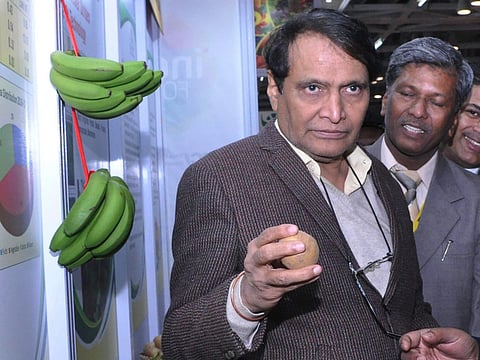India must take the lead in reforming WTO
New Delhi needs to invest more time and effort to put its agenda for discussion and negotiate favourable deals, leveraging its huge market

Last December, while returning from the eleventh World Trade Organisation (WTO) ministerial conference, which failed to adopt a permanent solution on the farm subsidy issue affecting the livelihoods and food security of more than half of the world’s population, India’s Commerce Minister Suresh Prabhu had made up his mind on the next course of action. Prabhu, a known go-getter and result-oriented professional, who had reshaped the landscape of India’s power sector during his stint as power minister in early 2000, was determined to do something for reinvigorating the watchdog of international trade. And to counter the growing protectionist pressure in the developed world — posing a serious threat to free trade and sustainable growth — Prabhu decided to host a mini-ministerial, yet more representative, meeting to be attended by trade ministers from at least 40 WTO member-states in New Delhi next March. Gopal Pillai, former Indian commerce secretary and the country’s ex-chief negotiator at WTO feels “a mini-ministerial meet is a step in the right direction provided we are very clear about what we want and do all the basic networking and collaboration with like-minded countries.” Pillai also rues the fact that despite developing and implementing a framework for action during 2004-2011, India seems to have lost focus thereafter.
Proliferation of economic nationalism in recent times has undoubtedly brought about a nuanced shift in the global trade agenda, with disdain for multilateral trade arrangements bursting the bubbles of globalisation and free-trade, essential for sustainable growth. Though protectionist rhetoric may not lead to an immediate shift away from trade multilateralism, does it, however, signal a declining appetite for trade liberalisation among advanced economies? Pillai does not feel so. “They only want trade liberalisation in sectors of advantage to them. The rest is for negotiation except in the case of the United States where the agricultural lobby has a veto, because of the country’s internal political architecture” says Pillai. Since trade today is a key principle of war and political and economic dominance, India’s former chief trade negotiator wants this to be tackled “head-on”. Pillai advocates developing an armoury of significant bargaining chips for trade-off during hard negotiations, citing how New Delhi compelled Washington to remove various non-trade barriers on Indian mangoes for hassle-free entry into American market, in exchange for hastening the import of Harley Davidson motorcycles into India, by relaxing certain pollution control standards that the vehicle failed to meet. Lamenting India’s lethargy in aggressively defending her position in international trade negotiations, using effective quid-pro-quo tools, Pillai explains how simple steps, like making it mandatory to label import products in regional Indian languages, can work wonders.
A 2017 United Nations report reveals, there has been a quantum leap in the number of undernourished people across the globe, from 777 million in 2015 to 815 million in 2016, while India alone is home to 190.7 million of them — the largest globally. With 14.5 per cent of the population undernourished, 21 per cent suffering from wasting, 38.4 per cent of under-five children stunted and 51.4 per cent of women in reproductive age-group found to be anaemic, India is duty-bound to provide nutritious food to those hundreds and millions living in abject poverty and bereft of food security. And an assured minimum support price for agricultural produce is the only viable way of fighting hunger and protecting the predominantly agrarian societies in developing countries. However, WTO’s lopsided regulations and prevailing apprehensions — about subsidised food procurement initiatives distorting global commodity prices — among net food importing nations have prevented a permanent colony on public food stockpile issue. “Most developed countries have been smart enough to redesign their support to fit into the Green Box which is theoretically non-distorting” says an internationally renowned trade diplomat, and asked India to ponder whether she too can devise similar out-of-the-box solution.
With emergence of attractive markets in the developing world, and countries like India and China graduating into significant players, influencing the new global trade agenda, there is a perceptible shift in the distribution of bargaining power among group of nations identified by their economic clout. In this backdrop, a question that inevitably creeps in is whether WTO rules needs to be revamped for restoring the primacy of the organisation as a neutral promoter of rule-based world trade, apart from preserving its relevance for posterity. According to the trade diplomat, the last major rules revision took place in the Uruguay Round in 1994, even though the nature, direction and structure of global trade have undergone very deep changes ever since, due to factors like expanding cross-border financial flows, rise of China, emergence of global value chains and sharp increase in services trade due to digitisation. “The issue, however, is not whether changes should be negotiated, but whether WTO members can agree on a negotiating agenda” contends the diplomat, adding, the deadlocked Doha Round made it politically difficult to concur on a multilateral negotiating agenda. He therefore foresees a spurt in plurilateral initiatives. But what should be India’s agenda in the altered context? While Pillai wants a clear strategy based on domestic consensus, the trade diplomat underscores the necessity of undertaking data-based analysis to maintain a fine balance between India’s long-standing concerns and emerging interests in the new trading order. Most importantly, India needs to invest more time and effort to put her agenda for discussion and negotiate favourable package deals, leveraging her huge market.
Seema Sengupta is a journalist and columnist based in Kolkata, India.
Sign up for the Daily Briefing
Get the latest news and updates straight to your inbox



